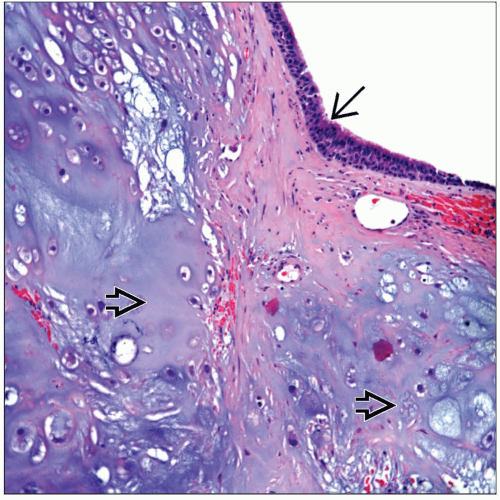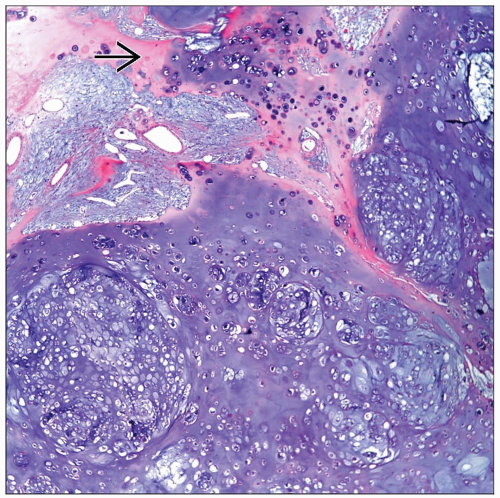Chrondrosarcoma
Key Facts
Terminology
Malignant mesenchymal neoplasm with cartilaginous differentiation
Clinical Issues
Incidence
Primary chondrosarcomas of lung are exceedingly rare
More common in 6th and 7th decades of life
Can be either central or peripheral tumors
Symptoms
Shortness of breath
Hemoptysis
Cough
Bronchial obstruction
Microscopic Pathology
Atypical cartilage
Chondromyxoid
Myxoid
Mesenchymal
Top Differential Diagnoses
Hamartoma shows invagination of respiratory epithelium
Shows mixed areas with adipose tissue
Carcinoma is a consideration in cases of mesenchymal chondrosarcoma
Shows positive staining with epithelial markers
Mixed tumor may also show other types of tissues
Carcinosarcoma should show evidence of epithelial component
TERMINOLOGY
Definitions
Malignant mesenchymal neoplasm with cartilaginous differentiation
CLINICAL ISSUES
Epidemiology
Incidence
Primary chondrosarcomas of lung are exceedingly rare
Age
Primary chondrosarcomas of lung are more common in 6th and 7th decades of life
Gender
No gender predilection
Site
Primary chondrosarcomas in lung can be either central or peripheral
Presentation
Shortness of breath
Hemoptysis
Cough
Bronchial obstruction
Asymptomatic
Treatment
Surgical approaches
Lobectomy
Sleeve resection
Pneumonectomy
Adjuvant therapy
Chemo-radiation is questionable
Prognosis
Central tumors may have less aggressive behavior
Peripheral tumors may follow more aggressive behavior
Survival is poor
MACROSCOPIC FEATURES
General Features
Tumor may obliterate bronchial lumen in central tumors
Peripheral tumors are usually larger
Well-delineated tumors
White with slightly lobulated appearance
Hard or mucoid consistency
Size
Varies from 1-2 cm to > 10 cm in diameter
MICROSCOPIC PATHOLOGY
Histologic Features
Atypical cartilage
Chondromyxoid
Myxoid
Mesenchymal
Predominant Pattern/Injury Type
Chondromyxoid
Stay updated, free articles. Join our Telegram channel

Full access? Get Clinical Tree







